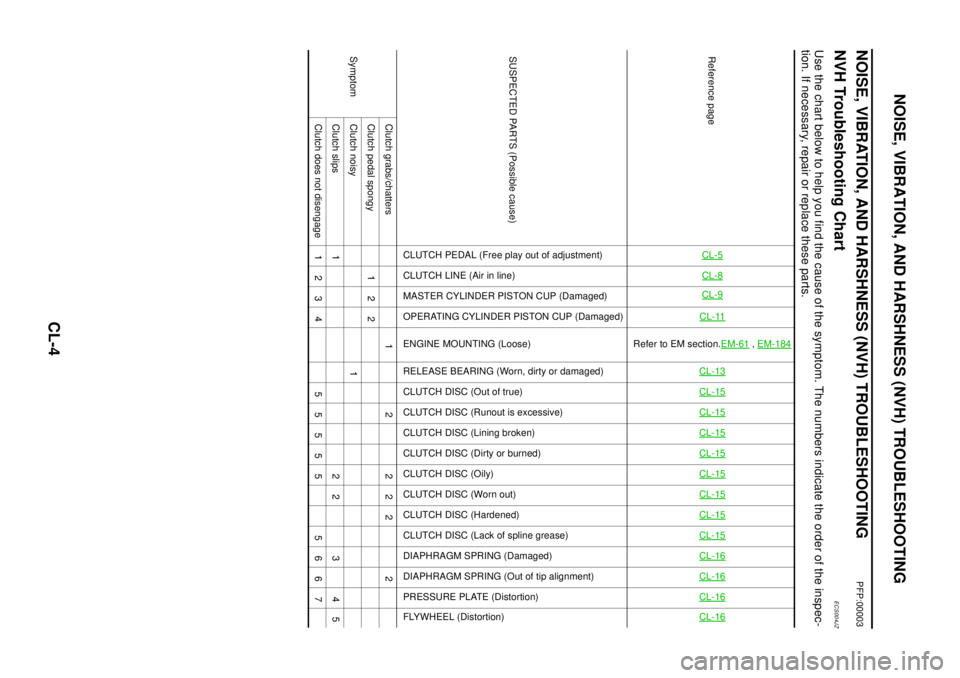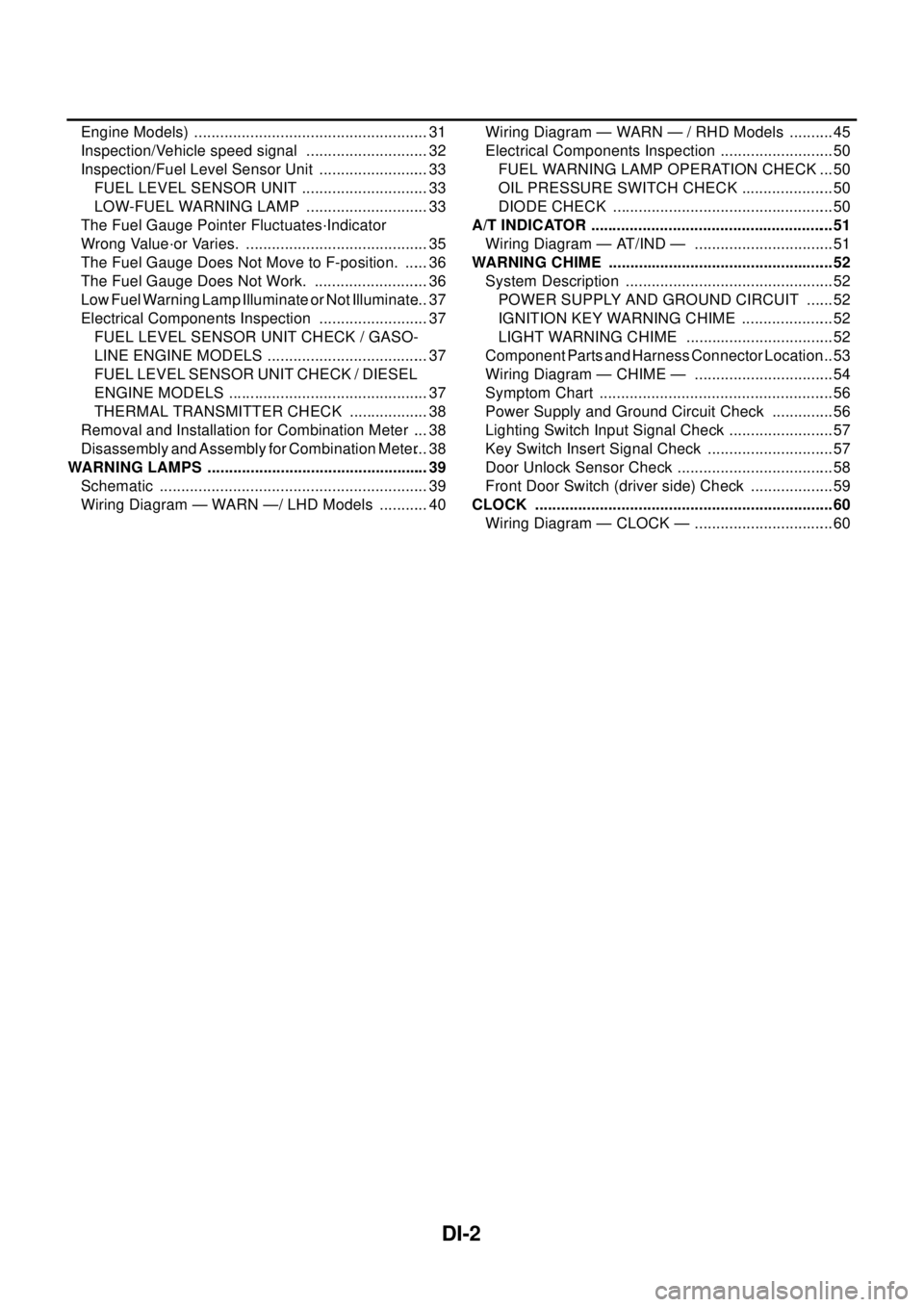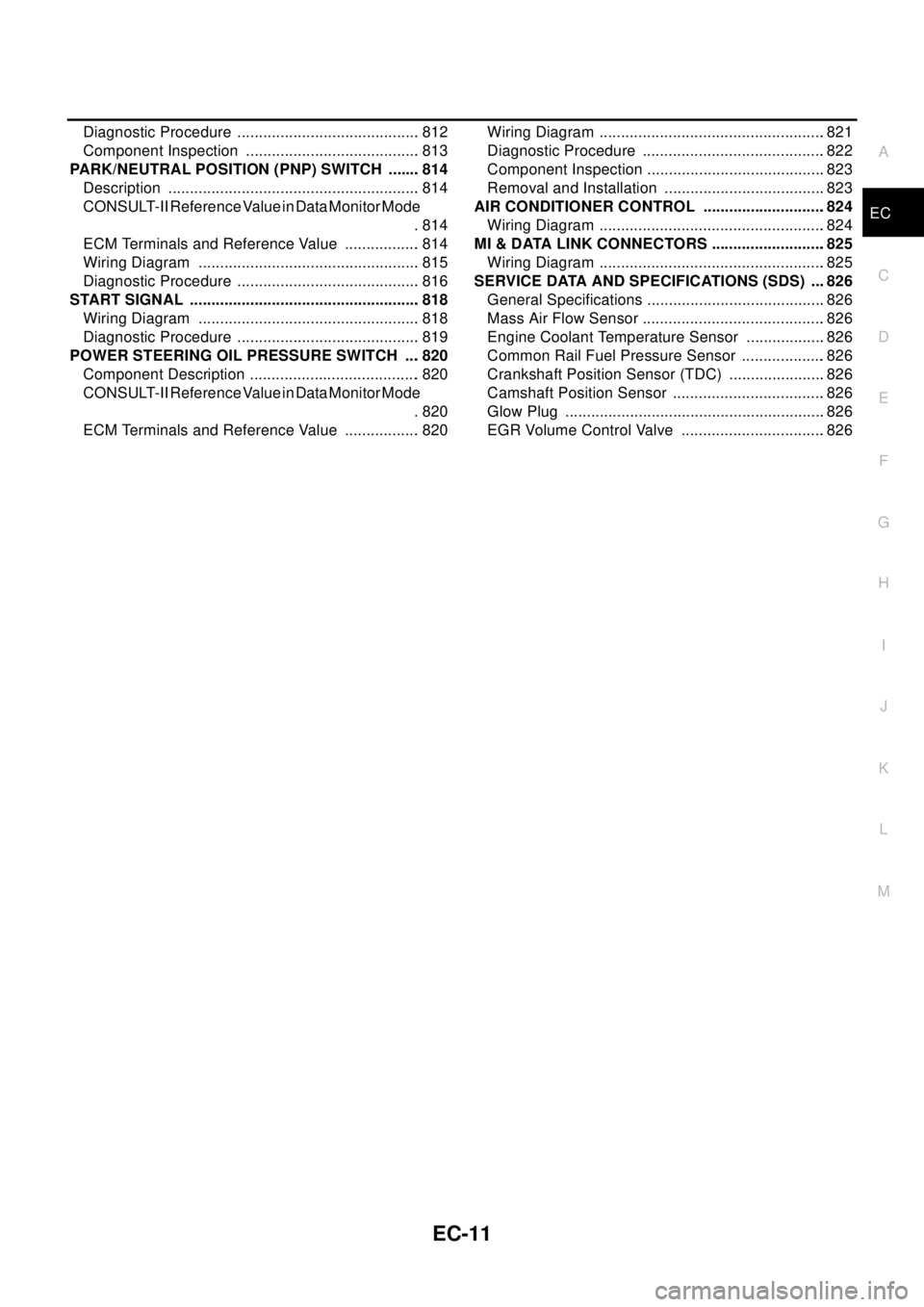2003 NISSAN X-TRAIL low oil pressure
[x] Cancel search: low oil pressurePage 872 of 3066
![NISSAN X-TRAIL 2003 Electronic Repair Manual BRC-4
[4WD/ABS]
PRECAUTIONS
[4WD/ABS]PRECAUTIONSPFP:00001
Precautions for brake systemEFS001B6
lRecommended fluid is brake fluid “DOT 3 ”or “DOT 4”.
lNever reuse drained brake fluid.
lBe caref NISSAN X-TRAIL 2003 Electronic Repair Manual BRC-4
[4WD/ABS]
PRECAUTIONS
[4WD/ABS]PRECAUTIONSPFP:00001
Precautions for brake systemEFS001B6
lRecommended fluid is brake fluid “DOT 3 ”or “DOT 4”.
lNever reuse drained brake fluid.
lBe caref](/manual-img/5/57402/w960_57402-871.png)
BRC-4
[4WD/ABS]
PRECAUTIONS
[4WD/ABS]PRECAUTIONSPFP:00001
Precautions for brake systemEFS001B6
lRecommended fluid is brake fluid “DOT 3 ”or “DOT 4”.
lNever reuse drained brake fluid.
lBe careful not to splash brake fluid on painted areas.
lTo clean or wash all parts of master cylinder, disc brake caliper and wheel cylinder, use clean brake fluid.
lNever use mineral oils such as gasoline or kerosene. They will ruin rubber parts of the hydraulic system.
lUse flare nut wrench when removing and installing brake tube.
lAlways torque brake lines when installing.
lBurnish the brake contact surfaces after refinishing or replacing
drums or rotors, after replacing pads or linings, or if a soft pedal
occurs at very low mileage. Refer toBR-10, "
Brake Burnishing
Procedure".
lBefore working, turn OFF ignition switch. Disconnect connectors
for ABS actuator and control module or battery terminals.
WAR NIN G:
lClean brake pads and shoes with a waste cloth, then wipe
with a dust collector.
Precautions for brake controlEFS001B7
lIf malfunction is indicated by 4WD warning lamp and/or ABS warning lamp, collect necessary information
from customer (what symptoms are present under what conditions). Find out possible causes before start-
ing service. Besides electrical system inspection, check operation of ABS actuator.
lIf malfunction is detected, proceed to trouble diagnosis after checking tire pressure and tire wear.
lStopping distance or steering stability may be deteriorated by the following conditions. Tire size and type
are in improper combination. Brake pads are not Nissan genuine parts.
lFitting tires of different size on vehicle can be cause of longitudinal vibration. Always use tires of the same
size and brand. Exchange front and rear tires on the following conditions: Longitudinal vibration occurs in
vehicle with tires of the same size and brand. After replacement, perform trouble diagnosis. 1580|None
l4WD/ABS function may have a failure or error under following condition: There is radio, antenna, or
antenna lead-in wire (including wiring) near control module.
lIf aftermarket parts (e.g. Car stereo equipment, CD player) have been installed, check electrical har-
nesses for pinches, open, and improper wiring.
SBR686C
Page 996 of 3066

CL-4
NOISE, VIBRATION, AND HARSHNESS (NVH) TROUBLESHOOTING
NOISE, VIBRATION, AND HARSHNESS (NVH) TROUBLESHOOTING
PFP:00003
NVH Troubleshooting ChartECS004JZ
Use the chart below to help you find the cause of the symptom. The numbers indicate the order of the inspec-
tion. If necessary, repair or replace these parts.
Reference pageCL-5CL-8CL-9CL-11
Refer to EM section.EM-61
,EM-184
CL-13CL-15CL-15CL-15CL-15CL-15CL-15CL-15CL-15CL-16CL-16CL-16CL-16
SUSPECTED PARTS (Possible cause)
CLUTCH PEDAL (Free play out of adjustment)
CLUTCH LINE (Air in line)
MASTER CYLINDER PISTON CUP (Damaged)
OPERATING CYLINDER PISTON CUP (Damaged)
ENGINE MOUNTING (Loose)
RELEASE BEARING (Worn, dirty or damaged)
CLUTCH DISC (Out of true)
CLUTCH DISC (Runout is excessive)
CLUTCH DISC (Lining broken)
CLUTCH DISC (Dirty or burned)
CLUTCH DISC (Oily)
CLUTCH DISC (Worn out)
CLUTCH DISC (Hardened)
CLUTCH DISC (Lack of spline grease)
DIAPHRAGM SPRING (Damaged)
DIAPHRAGM SPRING (Out of tip alignment)
PRESSURE PLATE (Distortion)
FLYWHEEL (Distortion)
SymptomClutch grabs/chatters 1 2 2 2 2 2
Clutch pedal spongy 1 2 2
Clutch noisy 1
Clutch slips 1 2 2 3 4 5
Clutchdoesnotdisengage 1234 55555 5667
Page 1022 of 3066
![NISSAN X-TRAIL 2003 Electronic Repair Manual CO-12
[QR20DE]
RADIATOR
RADIATOR
PFP:21400
Removal and InstallationEBS009SF
WAR NIN G:
Never remove the radiator cap when the engine is hot. Serious burns could occur from high pressure
coolant escapi NISSAN X-TRAIL 2003 Electronic Repair Manual CO-12
[QR20DE]
RADIATOR
RADIATOR
PFP:21400
Removal and InstallationEBS009SF
WAR NIN G:
Never remove the radiator cap when the engine is hot. Serious burns could occur from high pressure
coolant escapi](/manual-img/5/57402/w960_57402-1021.png)
CO-12
[QR20DE]
RADIATOR
RADIATOR
PFP:21400
Removal and InstallationEBS009SF
WAR NIN G:
Never remove the radiator cap when the engine is hot. Serious burns could occur from high pressure
coolant escaping from the radiator. Wrap a thick cloth around the cap. Slowly turn it a quarter turn to
allow built-up pressure to escape. Carefully remove the cap by turning it all the way.
REMOVAL
1. Drain coolant. Refer toCO-9, "DRAINING ENGINE COOLANT".
2. Remove air duct with air cleaner assembly.
3. Remove A/T oil cooler hose.
lInstall blind plug to avoid leakage of A/T fluid.
4. Disconnect radiator upper hose, lower hose and mounting bracket.
5. Remove radiator and radiator fan assembly
CAUTION:
lDo not damage or scratch radiator core when removing.
INSTALLATION
lReinstall any parts removed in reverse order of removal.
lCheck for coolant leaks. Refer toCO-9, "LEAK CHECK".
PBIC0237E
1 Radiator 2 Bracket 3 Mounting rubber
4 A/T oil cooler hose 5 Radiator hose (lower) 6 Radiator fan assembly
7 Reservoir tank 8 Radiator hose (upper) 9 Radiator filler cap
Page 1029 of 3066
![NISSAN X-TRAIL 2003 Electronic Repair Manual WATER PUMP
CO-19
[QR20DE]
C
D
E
F
G
H
I
J
K
L
MA
CO
WATER P UM PPFP:21020
Removal and InstallationEBS009SJ
WA RN ING:
Never remove the radiator cap when the engine is hot. Serious burns could occur fr NISSAN X-TRAIL 2003 Electronic Repair Manual WATER PUMP
CO-19
[QR20DE]
C
D
E
F
G
H
I
J
K
L
MA
CO
WATER P UM PPFP:21020
Removal and InstallationEBS009SJ
WA RN ING:
Never remove the radiator cap when the engine is hot. Serious burns could occur fr](/manual-img/5/57402/w960_57402-1028.png)
WATER PUMP
CO-19
[QR20DE]
C
D
E
F
G
H
I
J
K
L
MA
CO
WATER P UM PPFP:21020
Removal and InstallationEBS009SJ
WA RN ING:
Never remove the radiator cap when the engine is hot. Serious burns could occur from high pressure
coolant escaping from the radiator.
REMOVAL
Water Pump Removal
1. Drain coolant. Refer toCO-9, "DRAINING ENGINE COOLANT".
CAUTION:
Perform when the engine is cold.
2. Remove the following parts.
lEngine under cover
lAlternator, water pump and air compressor belt
Refer to drive beltEM-13, "
Removal and Installation".
3. Remove water pump.
lCoolant will leak from the cylinder block, so have a receptacle ready below.
CAUTION:
lHandle the water pump vane so that it does not contact any other parts.
lWater pump cannot be disassembled and should be replaced as a unit.
Water Pump Housing Removal
1. Perform step 1 and 2 of “Water Pump Removal”.
2. Remove alternator.
3. Remove oil level gauge.
CAUTION:
Plug the oil level gauge guide opening to prevent oil pan from entering foreign materials.
4. Remove bolts mounting water pipe.
5. Remove water pump housing.
Water Pipe Removal
1. Remove water pump housing.
KBIA0154E
1 Water pump 2 Gasket 3 Water pump housing
4 Water pipe
Page 1050 of 3066
![NISSAN X-TRAIL 2003 Electronic Repair Manual CO-40
[YD22DDTi]
WATER PUMP
WAT ER PU M P
PFP:21020
Removal and InstallationEBS00BB4
WAR NIN G:
Never remove the radiator cap when the engine is hot. Serious burns could occur from high pressure
coola NISSAN X-TRAIL 2003 Electronic Repair Manual CO-40
[YD22DDTi]
WATER PUMP
WAT ER PU M P
PFP:21020
Removal and InstallationEBS00BB4
WAR NIN G:
Never remove the radiator cap when the engine is hot. Serious burns could occur from high pressure
coola](/manual-img/5/57402/w960_57402-1049.png)
CO-40
[YD22DDTi]
WATER PUMP
WAT ER PU M P
PFP:21020
Removal and InstallationEBS00BB4
WAR NIN G:
Never remove the radiator cap when the engine is hot. Serious burns could occur from high pressure
coolant escaping from the radiator.
REMOVAL
1. Remove the under cover, splash cover (right), and drive belt.
2. Drain engine coolant. Refer toCO-30, "
DRAINING ENGINE COOLANT".
CAUTION:
Perform when the engine is cold.
3. Support the bottom of the oil pan with a floor jack etc, and remove the right engine mount bracket (front
side of the engine).
4. Remove the water pump pulley.
lLoosen the pulley bolts after fixing the pulley using a screwdriver etc.
5. Remove engine mount bracket.
6. Remove the water pump.
lCoolant will leak from the cylinder block, so have a receptacle ready below.
CAUTION:
lHandle the water pump vane so that it does not contact any other parts.
lWater pump cannot be disassembled and should be replaced as a unit.
INSPECTION AFTER REMOVAL
lVisually check that there is no significant dirt or rusting on the
water pump body and vane.
lCheck that there is no looseness in the vane shaft, and that it
turns smoothly when rotated by hand.
lIf there are any unusualness, replace the water pump assembly.
INSTALLATION
lInstall in the reverse order of removal
JLC294B
SBIA0132E
Page 1056 of 3066

DI-2
Engine Models) ....................................................... 31
Inspection/Vehicle speed signal ............................. 32
Inspection/Fuel Level Sensor Unit .......................... 33
FUEL LEVEL SENSOR UNIT .............................. 33
LOW-FUEL WARNING LAMP ............................. 33
The Fuel Gauge Pointer Fluctuates·Indicator
Wrong Value·or Varies. ........................................... 35
The Fuel Gauge Does Not Move to F-position. ...... 36
The Fuel Gauge Does Not Work. ........................... 36
Low Fuel Warning Lamp Illuminate or Not Illuminate... 37
Electrical Components Inspection .......................... 37
FUEL LEVEL SENSOR UNIT CHECK / GASO-
LINE ENGINE MODELS ...................................... 37
FUEL LEVEL SENSOR UNIT CHECK / DIESEL
ENGINE MODELS ............................................... 37
THERMAL TRANSMITTER CHECK ................... 38
Removal and Installation for Combination Meter .... 38
Disassembly and Assembly for Combination Meter... 38
WARNING LAMPS .................................................... 39
Schematic ............................................................... 39
Wiring Diagram — WARN —/ LHD Models ............ 40Wiring Diagram — WARN — / RHD Models ...........45
Electrical Components Inspection ...........................50
FUEL WARNING LAMP OPERATION CHECK ... 50
OIL PRESSURE SWITCH CHECK ......................50
DIODE CHECK ....................................................50
A/T INDICATOR .........................................................51
Wiring Diagram — AT/IND — .................................51
WARNING CHIME .....................................................52
System Description .................................................52
POWER SUPPLY AND GROUND CIRCUIT .......52
IGNITION KEY WARNING CHIME ......................52
LIGHT WARNING CHIME ...................................52
Component Parts and Harness Connector Location... 53
Wiring Diagram — CHIME — .................................54
Symptom Chart .......................................................56
Power Supply and Ground Circuit Check ...............56
Lighting Switch Input Signal Check .........................57
Key Switch Insert Signal Check ..............................57
Door Unlock Sensor Check .....................................58
Front Door Switch (driver side) Check ....................59
CLOCK ......................................................................60
Wiring Diagram — CLOCK — .................................60
Page 1125 of 3066

EC-11
C
D
E
F
G
H
I
J
K
L
M
ECA Diagnostic Procedure ........................................... 812
Component Inspection ......................................... 813
PARK/NEUTRAL POSITION (PNP) SWITCH ........ 814
Description ........................................................... 814
CONSULT-II Reference Value in Data Monitor Mode
. 814
ECM Terminals and Reference Value .................. 814
Wiring Diagram .................................................... 815
Diagnostic Procedure ........................................... 816
START SIGNAL ...................................................... 818
Wiring Diagram .................................................... 818
Diagnostic Procedure ........................................... 819
POWER STEERING OIL PRESSURE SWITCH .... 820
Component Description ........................................ 820
CONSULT-II Reference Value in Data Monitor Mode
. 820
ECM Terminals and Reference Value .................. 820Wiring Diagram .....................................................821
Diagnostic Procedure ...........................................822
Component Inspection ..........................................823
Removal and Installation ......................................823
AIR CONDITIONER CONTROL .............................824
Wiring Diagram .....................................................824
MI & DATA LINK CONNECTORS ...........................825
Wiring Diagram .....................................................825
SERVICE DATA AND SPECIFICATIONS (SDS) ....826
General Specifications ..........................................826
Mass Air Flow Sensor ...........................................826
Engine Coolant Temperature Sensor ...................826
Common Rail Fuel Pressure Sensor ....................826
Crankshaft Position Sensor (TDC) .......................826
Camshaft Position Sensor ....................................826
Glow Plug .............................................................826
EGR Volume Control Valve ..................................826
Page 1149 of 3066
![NISSAN X-TRAIL 2003 Electronic Repair Manual BASIC SERVICE PROCEDURE
EC-35
[QR (WITH EURO-OBD)]
C
D
E
F
G
H
I
J
K
L
MA
EC
lTo avoid unnecessary force or tension to hose, use moderately long fuel hose for fuel pressure check.
lDo not use the fuel NISSAN X-TRAIL 2003 Electronic Repair Manual BASIC SERVICE PROCEDURE
EC-35
[QR (WITH EURO-OBD)]
C
D
E
F
G
H
I
J
K
L
MA
EC
lTo avoid unnecessary force or tension to hose, use moderately long fuel hose for fuel pressure check.
lDo not use the fuel](/manual-img/5/57402/w960_57402-1148.png)
BASIC SERVICE PROCEDURE
EC-35
[QR (WITH EURO-OBD)]
C
D
E
F
G
H
I
J
K
L
MA
EC
lTo avoid unnecessary force or tension to hose, use moderately long fuel hose for fuel pressure check.
lDo not use the fuel hose for checking fuel pressure with damage or cracks on it.
lUse Pressure Gauge to check fuel pressure.
3. Remove fuel hose. Refer toEM-17, "
INTAKE MANIFOLD".
lDo not twist or kink fuel hose because it is plastic hose.
lDo not remove fuel hose from quick connector.
lKeep the original fuel hose to be free from intrusion of dust or foreign substances with a suitable cover.
4. Install the fuel pressure gauge as shown in the figure.
lWipe off oil or dirt from hose insertion part using cloth moist-
ened with gasoline.
lApply proper amount of gasoline between top of the fuel tube
and No.1 spool.
lInsert fuel hose for fuel pressure check until it touches the
No.1 spool on fuel tube.
lUse NISSAN genuine hose clamp (part number: 16439
N4710 or 16439 40U00).
lWhen reconnecting fuel line, always use new clamps.
lWhen reconnecting fuel hose, check the original fuel hose for
damage and abnormality.
lUse a torque driver to tighten clamps.
lInstall hose clamp to the position within 1 - 2 mm (0.04 - 0.08
in).
lMake sure that clamp screw does not contact adjacent parts.
5. After connecting fuel hose for fuel pressure check, pull the hose
with a force of approximately 98 N (10 kg, 22 lb) to confirm fuel
tube does not come off.
6. Turn ignition switch "ON", and check for fuel leakage.
7. Start engine and check for fuel leakage.
8. Read the indication of fuel pressure gauge.
lDo not perform fuel pressure check with system operating. Fuel pressure gauge may indicate false
readings.
lDuring fuel pressure check, confirm for fuel leakage from fuel connection every 3 minutes.
9. If result is unsatisfactory, go to next step.
10. Check the following.
lFuel hoses and fuel tubes for clogging
lFuel filter for clogging
lFuel pump
lFuel pressure regulator for clogging
If OK, replace fuel pressure regulator.
If NG, repair or replace.Tightening torque: 1 - 1.5 N·m (0.1 - 0.15 kg-m,
9-13in-lb)
At idling:
Approximately 350 kPa (3.5 bar, 3.7 kg/cm
2,51psi)
PBIB0669E
PBIB0670E